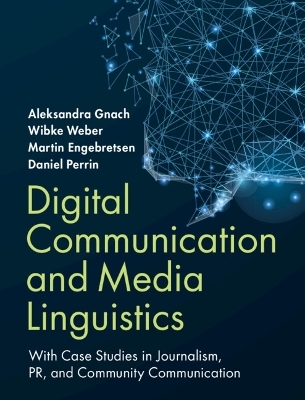
Digital Communication and Media Linguistics
Cambridge University Press (Verlag)
978-1-108-74827-8 (ISBN)
This textbook offers an interdisciplinary, comprehensive and state-of-the-art overview of the media linguistics approaches to explain and understand digital communication and multimodality. Linking the fields of communication studies, applied linguistics and journalism, it grounds communication practices in a deep understanding of the social and societal implications of language use in digital media. The tools to analyse multimodal texts are analysed in light of the advantages and constraints that different communication modes pose, both individually and in combination. Aimed at upper level undergraduates and graduates in applied linguistics, communication and media studies, including journalism and PR, this textbook contains case studies and professional examples highlighting the interplay between language use and digital communication and encouraging the reader to reflect on the themes covered, and put the acquired knowledge into practice. Online resources for students include videos, writing techniques, a guide to multimodal texts analysis, additional case studies and a glossary.
Aleksandra Gnach is Professor of Media Linguistics at ZHAW Zurich University of Applied Sciences, Switzerland. Her areas of interest include the use of social media at the interface between public and private communication and the production and use of new media formats (VR, AR, XR) in public communication. She is the co-founder of the IAM MediaLab, a participatory platform that brings together professionals and scholars from different fields to actively engage in the challenges of digital transformation. Wibke Weber is Professor of Media Linguistics at ZHAW Zurich University of Applied Sciences, Switzerland. Her research focuses on visual semiotics, image analysis, digital storytelling, data visualization, information design, multimodality, and virtual reality, and she has published several books and journal articles in all these areas. She has previously worked as a journalist in public and private media companies. Martin Engebretsen is Professor of Language and Communication at University of Agder, Norway. His research interests include visual and multimodal communication, rhetorics, discourse analysis, digital communication and journalism. He has published numerous books and journal articles at the intersection of linguistics and media studies. Prior to becoming an academic, he worked as a newspaper journalist. Daniel Perrin is Professor of Applied Linguistics and Vice President at 'ZHAW' Zurich University of Applied Sciences, Switzerland. His research focuses on text production in professional settings. Before starting his academic career, he worked as a journalist and writing coach and is still engaged in training and coaching media and communication professionals as well as leaders in education, economy, and politics in the framework of transdisciplinary projects.
Acknowledgements; Preface; 1. Starting Point: Digital Society and Media Linguistics; 2. Theoretical Context: Understanding Public Digital Communication; 3. Practical Context: From Writing to Multimodal Communication; 4. Professional Context: Journalism, PR, and Community Communication; 5. Doing Media Linguistic Research; 6. Doing Media Linguistic Analysis; 7. Case Studies; 8. Public Communication in Transformation: Algorithmic Culture; References; Appendix; Glossary; Index.
| Erscheinungsdatum | 07.01.2023 |
|---|---|
| Zusatzinfo | Worked examples or Exercises |
| Verlagsort | Cambridge |
| Sprache | englisch |
| Maße | 190 x 245 mm |
| Gewicht | 640 g |
| Themenwelt | Geisteswissenschaften ► Sprach- / Literaturwissenschaft ► Sprachwissenschaft |
| Sozialwissenschaften ► Kommunikation / Medien ► Journalistik | |
| Sozialwissenschaften ► Kommunikation / Medien ► Kommunikationswissenschaft | |
| Sozialwissenschaften ► Kommunikation / Medien ► Medienwissenschaft | |
| ISBN-10 | 1-108-74827-9 / 1108748279 |
| ISBN-13 | 978-1-108-74827-8 / 9781108748278 |
| Zustand | Neuware |
| Informationen gemäß Produktsicherheitsverordnung (GPSR) | |
| Haben Sie eine Frage zum Produkt? |
aus dem Bereich


